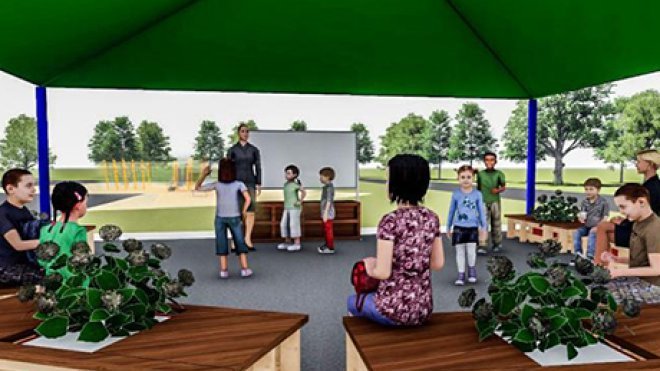Architecture Students’ Design Brings the Classroom Outdoors
Their plan for an outdoor classroom for Newport’s Pell Elementary School will be built this summer

NEWPORT, R.I. – Imagine an educational space that literally breaks down the walls of a traditional classroom, bringing students out into the natural environment for hands-on lessons in science, math and more. Thanks to a collaboration among Roger Williams University architecture students, the Newport School District and City of Newport, that will soon be a reality for more than 900 students at Pell Elementary School.
An emerging concept in early childhood education, an outdoor classroom offers students the ability to explore engaged learning opportunities that are better suited to being taught outdoors, where they can directly observe and interact with nature. For Pell Elementary School, it’s a way to enhance its strong STEM (science, technology, engineering and math) program provided to all of its kindergarten through fourth-grade students.
School officials loved the idea, but needed help to envision and design the space. That’s when they turned to RWU’s School of Architecture, Art and Historical Preservation (SAAHP), which has been collaborating with the Newport Tree Society on planting efforts at the school and around the city.
“We approached this project as a catalyst for expanding and improving the school’s STEM program,” said Chandler Hodder ’17, architecture major, photography minor and president of the RWU chapter of Freedom by Design, the architecture group that led the project design over two years. “As architecture students, we understand the importance of a tactile learning approach because our program is such a hands-on major.”
With that in mind, the students created an open space that would allow for a seamless connection with the environmentand the ability to use the classroom in multiple ways. Instead of walls, the classroom will reveal nature on all sides, shielded from sun and weather by a fabric covering. Inside will feature portable wooden benches inset with a center space for students to plant vibrant flowers and watch it grow; beneath the seats will be plastic bins to store resources in the classroom.
According to the school’s STEM specialists Mary Nordby and Lori Delemos – the teachers who partnered with RWU to create the outdoor classroom – textbook lessons will come alive when the students cultivate their own plants, witnessing the entire life cycle unfold before them. They will become scientists-in-training as they learn and record characteristics of a variety of tree species of the growing arboretum at the school, an initiative of the Newport Tree Society in partnership with RWU SAAHP. They will understand the roles math and physics play in scientific research. And they will embark upon engineering experiments too messy to undertake indoors.
“Having an outdoor classroom will make their STEM lessons more relevant and offer students different opportunities to apply their knowledge and skills in new ways,” Nordby said. “We hope it gets them more excited and engaged in STEM studies and interested in exploring careers they may not think about or know about, like being an astronaut or working in environmental science.”
After two years of planning, the school’s outdoor classroom will be constructed over the summer. Dozens of RWU architecture students have worked on the project, collaborating with school officials, Newport’s Buildings, Grounds and Facilities Division, and Newport Tree Society to match the vision while meeting building guidelines. They also partnered with Rogers High School’s Career and Technical Center, where they recently delivered the bench designs and worked with high school students to build the classroom seating.
For the architecture students, this project has been their own learning experience. From communicating with their partners to creating designs and cost estimates to holding on-campus charrettes to gain input from their peers and faculty members, they had the opportunity to apply their classroom knowledge to a real-world project, with this year’s Freedom by Design group – Chandler Hodder, Vincent Pacifico, Beverly Bienkiewicz and Katherine Hirsch – building upon the work of last year’s members. They also raised $8,000 for the project in grants from the American Institute of Architecture Students and New England Home Magazine.
“In architecture school, you want to build these crazy things,” Hodder said. “But when you get a real project, you have to scale it back and learn what it takes to be realistic. It’s helped me look at problems in a new way. You see the problem for what it is and how you have to approach it.”
“I get a larger sense of responsibility and real-world experience that will help me in my future career beyond just doing an academic project,” said Vincent Pacifico ’17, an architecture major and sustainability studies minor who served as construction manager for the project. “We are working with clients, and encountering problems that we had to solve. In the classroom, we learn the basics of how things work, theoretically, but the actual outcome is much different.”
The collaboration with Roger Williams University and other partners has been critical to the project’s success, according to Delemos. It’s inspired Pell Elementary School to seek more opportunities to work with RWU Freedom by Design.
“The best part of this project has been the collaboration that happened among all student levels, from kindergarten all the way to the college level, and including our community partners and the City of Newport,” Delemos said. “We’ve already told Freedom by Design that we want to continue our relationship. We have a few more projects that we can hopefully work together on.”
At RWU, we develop Civic Scholars who believe in community-engaged work. That’s why we commit to providing every student an opportunity that empowers them to put their knowledge and skills to the test solving real-world problems and creating meaningful change with community partners. Learn more about the Civic Scholars program and how to help us reach our goal of every student participating in civic scholarship.